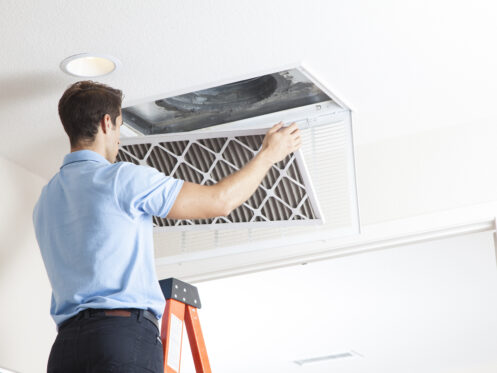When temperatures in Sacramento, CA plummet or soar, your heater and air conditioner keeps everyone in your home safe and comfortable. However, your HVAC ductwork plays an important hand as well. After all, without functional ducting, there’s no way for heated and cooled air to get where it needs to go. Although air ducts are largely out of sight and out of mind, they have a significant impact on HVAC efficiency, indoor air quality (IAQ), and more. Whether age-related, wear-related, or the result of pest infestation, these structures will eventually reach the end of their lifespan. The following are five signs that it’s time to replace them.
1. Your Ductwork Has Already Provided Nearly Two Decades of Service
Most HVAC air ducts are expected to last between 10 and 15 years. With diligent maintenance, some ducting might last as long as 20 to 25 years. This makes the lifespan of these features comparable to that of heaters, air conditioners, and many heat pumps. As such, homeowners are often advised to schedule air duct replacement when having new heating or cooling equipment installed.
Even when newly installed and structurally intact, ducting decreases the overall efficiency of HVAC systems. According to the University of Florida, ducted HVAC systems lose between 20% and 40% of their heating and cooling energy via these features. As air ducts age, they develop cracks, gaps, and other openings that allow conditioned air to flow out and unfiltered indoor air to enter. These same openings also serve as possible access points for pests like rats, mice, raccoons, and countless insects.
If your ductwork is between 10 and 15 years old, you should ask for an estimate of its remaining lifespan. Replacing aging ducts at the same time as your heat pump, AC, or heater will allow for the highest levels of HVAC system efficiency. It will also give us the chance to streamline these installations so that they perfectly support the nuances and needs of new heating and cooling equipment.
2. You’re Battling Persistent or Recurring Mold Issues
Persistent or recurring mold problems in any area of your home may be a sign of aging air ducts. When mold spores become airborne, they find their way into these systems where they’re constantly circulated and recirculated throughout the living environment. In relatively new air ducts, mold can often be treated with professional duct cleaning services or by installing integrated UV air sanitizing lights. However, in aging ductwork, recurring mold could be an indication of high humidity due to airflow obstructions, air leaks, or other structural or functional problems.
3. Your HVAC System Is Increasingly Noisy
Most heating and cooling equipment becomes increasingly noisy as it ages. Even with routine heating and cooling system maintenance, loose and worn parts can cause jarring banging, clanging, or rattling sounds during operation. As screws, bolts, and other components are gradually stripped by strong air forces and frequent friction and movement, keeping these parts tightened is an ongoing job.
However, if your ductwork emits a high-pitched whistling sound when your heater or air conditioner is on, this may be the sign of increased, in-duct pressure due to trapped debris and compromised airflow. It can also be an indication of ragged and torn ducting behind drywall or in other inconspicuous and difficult-to-access locations.
4. Your Home Energy Bill Has Skyrocketed
Fast-rising home energy bills can also be a sign that HVAC air ducts have reached the end of their lifespan. When your HVAC equipment’s air distribution system is riddled with air leaks, your heater and air conditioner have to work a lot harder to create the temperature changes you want. This is a solid argument for pairing new heaters and air conditioners with brand-new ductwork as it ensures that these upgrades aren’t sustaining undue, duct-related wear.
In homes with aging air ducts, heated and cooled air is often deposited behind drywall where it has virtually no impact on the temperature in living spaces. When your heater is on, you may even be able to detect this happening by simply placing your hand on your walls. If there’s an air leak in your HVAC air ducts, the drywall in front of this leak will likely feel warm to the touch.
Another way to determine whether leaky ducts are keeping you from getting heated or cooled air where it’s needed most is by timing your heating and cooling cycles and measuring temperature changes. For a healthy HVAC system, cooling cycles typically last between 15 and 20 minutes, and heating cycles typically last between 10 and 15 minutes. If your heater or air conditioner are running much longer than this but your indoor temperature isn’t changing, leaky ducts could be the culprit.
Home energy bills often accurately document the decline of HVAC air ducts. Take a look at your current energy bill and then compare it to your energy bill from this time last year. If you don’t have physical copies of old bills on hand, try logging into your utility account online and looking them up. You can also ask your utility service provider to mail you hard copies of your old statements or send you digital copies by email. Any dramatic rises in your energy use should be justifiable by household or building changes. If you haven’t added new family members or new energy-reliant appliances or fixtures to your home, changes in the integrity of your ducting are the most likely cause for cost increases.
5. There Are Visible Dents, Punctures, or Other Structural Duct Damages
Most homes have several areas in which HVAC air ducts are both exposed and unprotected. These are usually the garage, attic, and basement. However, if you’ve completed a post-construction ductwork retrofitting project at any time, these features could also be visible in other spaces.
Visible, unprotected air ducts are vulnerable to impact-related damage. Carelessly handled tools, ladders, shelves, and stored items can leave these structures with punctures, dents, and other imperfections. If your air ducts are relatively new but have been harmed by a falling item or another event, it may be possible to simply replace the damaged section. However, older ducts that are crushed, collapsed, or punctured frequently merit full-on duct replacement
Sometimes structural duct damage is the result of pest infestations. When rodents and other animals enter these systems, they can gnaw or chew at key features. Even the weight of these pests and their frequent movements can lead to sagging and collapse. It’s additionally important to note that all pests leave behind a fair amount of detritus in these channels, including shed exoskeletons, eggs, feces, hair, carcasses, and food. These leaves have a negative impact on indoor air quality. They can also leave homes smelling downright fetid when heating and cooling equipment is in use.
We proudly serve Sacramento, CA and the surrounding cities. Our clients can count on us for top-notch heating, cooling, and electrification services. We also provide insulation, whole-house fans, and HVAC air duct installation, maintenance, and repairs. If the time has come to replace your ductwork, give Atticman Heating and Air Conditioning, Insulation a call today.


